Phytoremediation Capability and Copper Uptake of Maize (Zea mays L.) in Copper Contaminated Soils
Abstract
:1. Introduction
2. Materials and Methods
2.1. Preparation and Characterization of Soil
2.2. Pot Experiments
2.3. Analysis of Copper in Plant Roots and Shoots
2.4. Translocation, Bioconcentration, and Bioaccumulation Factors and Phytoremediation Ratio
2.5. Statistical Analysis
3. Results and Discussion
3.1. Z. mays Growth
3.1.1. Germination rate of Z. mays in Copper-Treated Soils
3.1.2. Copper Toxic Impacts on Growth of Z. mays
3.2. Copper Uptake and Accumulation in Z. mays Tissues
3.3. Cu phytoextraction Efficiency
3.4. Phytoremediation Ratio (PR)
4. Conclusions
Author Contributions
Funding
Institutional Review Board Statement
Informed Consent Statement
Data Availability Statement
Acknowledgments
Conflicts of Interest
References
- Kleckerova, A.; Docekalová, H. Dandelion plants as a biomonitor of urban area contamination by heavy metals. Int. J. Environ. Res. 2014, 8, 157–164. [Google Scholar]
- Zand, A.D.; Hoveidi, H. Evaluation of the Potential of Burningbush (Kochia scoparia (L.) Schard) and Maize (Zea mays L.) and the Role of Soil Organic Amendment in Phytoremediation of Gasoline-Contaminated Soils. Int. J. Environ. Res. 2018, 12, 327–336. [Google Scholar] [CrossRef]
- Sarwar, N.; Imran, M.; Shaheen, M.R.; Ishaque, W.; Kamran, M.A.; Matloob, A.; Rehim, A.; Hussain, S. Phytoremediation strategies for soils contaminated with heavy metals: Modifications and future perspectives. Chemosphere 2017, 171, 710–721. [Google Scholar] [CrossRef] [PubMed]
- Maurya, P.K.; Malik, D.; Yadav, K.K.; Kumar, A.; Kumar, S.; Kamyab, H. Bioaccumulation and potential sources of heavy metal contamination in fish species in River Ganga basin: Possible human health risks evaluation. Toxicol. Rep. 2019, 6, 472–481. [Google Scholar] [CrossRef]
- Jaishankar, M.; Tseten, T.; Anbalagan, N.; Mathew, B.B.; Beeregowda, K.N. Toxicity, mechanism and health effects of some heavy metals. Interdiscip. Toxicol. 2014, 7, 60. [Google Scholar] [CrossRef] [PubMed] [Green Version]
- Järup, L. Hazards of heavy metal contamination. Br. Med. Bull. 2003, 68, 167–182. [Google Scholar] [CrossRef] [PubMed] [Green Version]
- Kumar, S.; Prasad, S.; Yadav, K.K.; Shrivastava, M.; Gupta, N.; Nagar, S.; Bach, Q.-V.; Kamyab, H.; Khan, S.A.; Yadav, S. Hazardous heavy metals contamination of vegetables and food chain: Role of sustainable remediation approaches’A review. Environ. Res. 2019, 179, 108792. [Google Scholar] [CrossRef] [PubMed]
- He, Z.; Shentu, J.; Yang, X.; Baligar, V.C.; Zhang, T.; Stoffella, P.J. Heavy metal contamination of soils: Sources, indicators and assessment. J. Environ. Indic. 2015, 9, 17–18. [Google Scholar]
- Ashraf, S.; Ali, Q.; Zahir, Z.A.; Ashraf, S.; Asghar, H.N. Phytoremediation: Environmentally sustainable way for reclamation of heavy metal polluted soils. Ecotoxicol. Environ. Saf. 2019, 174, 714–727. [Google Scholar] [CrossRef] [PubMed]
- McLaughlin, M.J.; Hamon, R.; McLaren, R.; Speir, T.; Rogers, S. A bioavailability-based rationale for controlling metal and metalloid contamination of agricultural land in Australia and New Zealand. Soil Res. 2000, 38, 1037–1086. [Google Scholar] [CrossRef]
- Missimer, T.M.; Teaf, C.M.; Beeson, W.T.; Maliva, R.G.; Woolschlager, J.; Covert, D.J. Natural background and anthropogenic arsenic enrichment in Florida soils, surface water, and groundwater: A review with a discussion on public health risk. Int. J. Environ. Res. Public Health 2018, 15, 2278. [Google Scholar] [CrossRef] [PubMed] [Green Version]
- Wu, F.-B.; Chen, F.; Wei, K.; Zhang, G.-P. Effect of cadmium on free amino acid, glutathione and ascorbic acid concentrations in two barley genotypes (Hordeum vulgare L.) differing in cadmium tolerance. Chemosphere 2004, 57, 447–454. [Google Scholar] [CrossRef] [PubMed]
- Adrees, M.; Ali, S.; Rizwan, M.; Ibrahim, M.; Abbas, F.; Farid, M.; Zia-ur-Rehman, M.; Irshad, M.K.; Bharwana, S.A. The effect of excess copper on growth and physiology of important food crops: A review. Environ. Sci. Pollut. Res. 2015, 22, 8148–8162. [Google Scholar] [CrossRef] [PubMed]
- Dučić, T.; Milenković, I.; Mutavdžić, D.; Nikolić, M.; de Yuso, M.V.M.; Vučinić, Ž.; Algarra, M.; Radotić, K. Estimation of carbon dots amelioration of copper toxicity in maize studied by synchrotron radiation-FTIR. Colloids Surf. B Biointerfaces 2021, 204, 111828. [Google Scholar] [CrossRef] [PubMed]
- Mantovi, P.; Bonazzi, G.; Maestri, E.; Marmiroli, N. Accumulation of copper and zinc from liquid manure in agricultural soils and crop plants. Plant Soil 2003, 250, 249–257. [Google Scholar] [CrossRef]
- Gang, A.; Vyas, A.; Vyas, H. Toxic effect of heavy metals on germination and seedling growth of wheat. J. Environ. Res. Dev. 2013, 8, 206–213. [Google Scholar]
- Xu, J.; Yang, L.; Wang, Z.; Dong, G.; Huang, J.; Wang, Y. Effects of soil copper concentration on growth, development and yield formation of rice (Oryza sativa). Rice Sci. 2005, 12, 125. [Google Scholar]
- Jaiswal, A.; Verma, A.; Jaiswal, P. Detrimental effects of heavy metals in soil, plants, and aquatic ecosystems and in humans. J. Environ. Pathol. Toxicol. Oncol. 2018, 37, 183–197. [Google Scholar] [CrossRef]
- Shrivastava, A. A review on copper pollution and its removal from water bodies by pollution control technologies. Indian J. Environ. Prot. 2009, 29, 552–560. [Google Scholar]
- Lone, M.I.; He, Z.-l.; Stoffella, P.J.; Yang, X.-e. Phytoremediation of heavy metal polluted soils and water: Progresses and perspectives. J. Zhejiang Univ. Sci. B 2008, 9, 210–220. [Google Scholar] [CrossRef] [Green Version]
- Hechmi, N.; Aissa, N.B.; Abdennaceur, H.; Jedidi, N. Phytoremediation potential of maize (Zea mays L.) in co-contaminated soils with pentachlorophenol and cadmium. Int. J. Phytoremediat. 2013, 15, 703–713. [Google Scholar] [CrossRef] [PubMed]
- Rodrigo Miyazaki, F.; Pilecco, M.; Bigaton, D. Foliar copper uptake by maize plants: Effects on growth and yield. Ciênc. Rural 2013, 43, 1561–1568. [Google Scholar]
- Macek, T.; Macková, M.; Káš, J. Exploitation of plants for the removal of organics in environmental remediation. Biotechnol. Adv. 2000, 18, 23–34. [Google Scholar] [CrossRef]
- Sharma, S.; Rana, S.; Thakkar, A.; Baldi, A.; Murthy, R.; Sharma, R. Physical, chemical and phytoremediation technique for removal of heavy metals. J. Heavy Met. Toxic. Dis. 2016, 1, 1–15. [Google Scholar]
- Chua, J.; Banua, J.M.; Arcilla, I.; Orbecido, A.; de Castro, M.E.; Ledesma, N.; Deocaris, C.; Madrazo, C.; Belo, L. Phytoremediation potential and copper uptake kinetics of Philippine bamboo species in copper contaminated substrate. Heliyon 2019, 5, e02440. [Google Scholar] [CrossRef] [Green Version]
- Wuana, R.A.; Okieimen, F.E. Heavy metals in contaminated soils: A review of sources, chemistry, risks and best available strategies for remediation. Int. Sch. Res. Not. 2011, 2011, 402647. [Google Scholar] [CrossRef] [Green Version]
- Pilon-Smits, E. Phytoremediation. Annu. Rev. Plant Biol. 2005, 56, 15–39. [Google Scholar] [CrossRef]
- Singh, O.; Jain, R. Phytoremediation of toxic aromatic pollutants from soil. Appl. Microbiol. Biotechnol. 2003, 63, 128–135. [Google Scholar] [CrossRef]
- Burt, R. Kellogg Soil Survey Laboratory Methods Manual; United States Department of Agriculture, Natural Resources Conservation: Washington, DC, USA, 2014.
- Dewis, J.; Freitas, F. Physical and Chemical Methods of Soil and Water Analysis; FAO Soils Bulletin: Rome, Italy, 1970. [Google Scholar]
- Walkley, A.; Black, I.A. An examination of the Degtjareff method for determining soil organic matter, and a proposed modification of the chromic acid titration method. Soil Sci. 1934, 37, 29–38. [Google Scholar] [CrossRef]
- Gil-Díaz, M.; Pinilla, P.; Alonso, J.; Lobo, M. Viability of a nanoremediation process in single or multi-metal (loid) contaminated soils. J. Hazard. Mater. 2017, 321, 812–819. [Google Scholar] [CrossRef]
- Wannaz, E.D.; Carreras, H.A.; Abril, G.A.; Pignata, M.L. Maximum values of Ni2+, Cu2+, Pb2+ and Zn2+ in the biomonitor Tillandsia capillaris (Bromeliaceae): Relationship with cell membrane damage. Environ. Exp. Bot. 2011, 74, 296–301. [Google Scholar] [CrossRef]
- Fang, R. Application of Atomic Absorption Spectroscopy in Sanitary Test; Beijing University Press: Beijing, China, 1991; Volume 15, pp. 148–158. [Google Scholar]
- Amin, H.; Arain, B.A.; Jahangir, T.M.; Abbasi, A.R.; Mangi, J.; Abbasi, M.S.; Amin, F. Copper (Cu) tolerance and accumulation potential in four native plant species: A comparative study for effective phytoextraction technique. Geol. Ecol. Landsc. 2021, 5, 53–64. [Google Scholar] [CrossRef] [Green Version]
- Embrandiri, A.; Rupani, P.; Shahadat, M.; Singh, R.; Ismail, S.; Ibrahim, M.; Kadir, M.A. The phytoextraction potential of selected vegetable plants from soil amended with oil palm decanter cake. Int. J. Recycl. Org. Waste Agric. 2017, 6, 37–45. [Google Scholar] [CrossRef] [Green Version]
- Singh, D.; Nath, K.; Sharma, Y.K. Response of wheat seed germination and seedling growth under copper stress. J. Environ. Biol. 2007, 28, 409. [Google Scholar]
- Htwe, T.; Onthong, J.; Duangpan, S.; Techato, K.; Chotikarn, P.; Sinutok, S. Effect of Copper Contamination on Plant Growth and Metal Contents in Rice Plant (Oryza Sativa L.). Commun. Soil Sci. Plant Anal. 2020, 51, 2349–2360. [Google Scholar] [CrossRef]
- Sekara, A.; Poniedzialeek, M.; Ciura, J.; Jedrszczyk, E. Zinc and copper accumulation and distribution in the tissues of nine crops: Implications for phytoremediation. Pol. J. Environ. Stud. 2005, 14, 829–835. [Google Scholar]
- Li, X.; Yang, Y.; Zhang, J.; Jia, L.; Li, Q.; Zhang, T.; Qiao, K.; Ma, S. Zinc induced phytotoxicity mechanism involved in root growth of Triticum aestivum L. Ecotoxicol. Environ. Saf. 2012, 86, 198–203. [Google Scholar] [CrossRef]
- Azeez, M.; Adesanwo, O.; Adepetu, J. Effect of Copper (Cu) application on soil available nutrients and uptake. Afr. J. Agric. Res. 2015, 10, 359–364. [Google Scholar]
- Sytar, O.; Brestic, M.; Taran, N.; Zivcak, M. Plants used for biomonitoring and phytoremediation of trace elements in soil and water. In Plant Metal Interaction; Elsevier: Amsterdam, The Netherlands, 2016; pp. 361–384. [Google Scholar]
- Chen, Z.-J.; Tian, Y.-H.; Zhang, Y.; Song, B.-R.; Li, H.-C.; Chen, Z.-H. Effects of root organic exudates on rhizosphere microbes and nutrient removal in the constructed wetlands. Ecol. Eng. 2016, 92, 243–250. [Google Scholar] [CrossRef]
- Napoli, M.; Cecchi, S.; Grassi, C.; Baldi, A.; Zanchi, C.A.; Orlandini, S. Phytoextraction of copper from a contaminated soil using arable and vegetable crops. Chemosphere 2019, 219, 122–129. [Google Scholar] [CrossRef]
- Huang, R.; Dong, M.; Mao, P.; Zhuang, P.; Paz-Ferreiro, J.; Li, Y.; Li, Y.; Hu, X.; Netherway, P.; Li, Z. Evaluation of phytoremediation potential of five Cd (hyper) accumulators in two Cd contaminated soils. Sci. Total Environ. 2020, 721, 137581. [Google Scholar] [CrossRef] [PubMed]
- Adrees, M.; Ali, S.; Rizwan, M.; Zia-ur-Rehman, M.; Ibrahim, M.; Abbas, F.; Farid, M.; Qayyum, M.F.; Irshad, M.K. Mechanisms of silicon-mediated alleviation of heavy metal toxicity in plants: A review. Ecotoxicol. Environ. Saf. 2015, 119, 186–197. [Google Scholar] [CrossRef] [PubMed]
- Singh, S.; Parihar, P.; Singh, R.; Singh, V.P.; Prasad, S.M. Heavy metal tolerance in plants: Role of transcriptomics, proteomics, metabolomics, and ionomics. Front. Plant Sci. 2016, 6, 1143. [Google Scholar] [CrossRef] [PubMed] [Green Version]
- Bhargava, A.; Carmona, F.F.; Bhargava, M.; Srivastava, S. Approaches for enhanced phytoextraction of heavy metals. J. Environ. Manag. 2012, 105, 103–120. [Google Scholar] [CrossRef]
- Wyszkowski, M.; Brodowska, M.S. Phytoextraction with Maize of Soil Contaminated with Copper after Application of Mineral and Organic Amendments. Agronomy 2020, 10, 1597. [Google Scholar] [CrossRef]
- Allard, A.-S.; Remberger, M.; Neilson, A.H. The negative impact of aging on the loss of PAH components in a creosote-contaminated soil. Int. Biodeterior. Biodegrad. 2000, 46, 43–49. [Google Scholar] [CrossRef]
- Korzeniowska, J.; Stanislawska-Glubiak, E.; Igras, J. Applicability of energy crops for metal phytostabilization of soils moderately contaminated with copper, nickel and zinc. J Food Agric. Environ. 2011, 9, 693–697. [Google Scholar]
- Zaier, H.; Ghnaya, T.; Lakhdar, A.; Baioui, R.; Ghabriche, R.; Mnasri, M.; Sghair, S.; Lutts, S.; Abdelly, C. Comparative study of Pb-phytoextraction potential in Sesuvium portulacastrum and Brassica juncea: Tolerance and accumulation. J. Hazard. Mater. 2010, 183, 609–615. [Google Scholar] [CrossRef]
- Rehman, M.; Maqbool, Z.; Peng, D.; Liu, L. Morpho-physiological traits, antioxidant capacity and phytoextraction of copper by ramie (Boehmeria nivea L.) grown as fodder in copper-contaminated soil. Environ. Sci. Pollut. Res. 2019, 26, 5851–5861. [Google Scholar] [CrossRef]
- Shu, X.; Yin, L.; Zhang, Q.; Wang, W. Effect of Pb toxicity on leaf growth, antioxidant enzyme activities, and photosynthesis in cuttings and seedlings of Jatropha curcas L. Environ. Sci. Pollut. Res. 2012, 19, 893–902. [Google Scholar] [CrossRef]
- Huang, C.; Lai, C.; Xu, P.; Zeng, G.; Huang, D.; Zhang, J.; Zhang, C.; Cheng, M.; Wan, J.; Wang, R. Lead-induced oxidative stress and antioxidant response provide insight into the tolerance of Phanerochaete chrysosporium to lead exposure. Chemosphere 2017, 187, 70–77. [Google Scholar] [CrossRef] [PubMed]
- Sun, Y.; Zhou, Q.; Wang, L.; Liu, W. The influence of different growth stages and dosage of EDTA on Cd uptake and accumulation in Cd-hyperaccumulator (Solanum nigrum L.). Bull. Environ. Contam. Toxicol. 2009, 82, 348–353. [Google Scholar] [CrossRef] [PubMed]
- Wang, S.; Shi, X.; Sun, H.; Chen, Y.; Pan, H.; Yang, X.; Rafiq, T. Variations in metal tolerance and accumulation in three hydroponically cultivated varieties of Salix integra treated with lead. PLoS ONE 2014, 9, e108568. [Google Scholar] [CrossRef] [PubMed]
- El-Temsah, Y.S.; Sevcu, A.; Bobcikova, K.; Cernik, M.; Joner, E.J. DDT degradation efficiency and ecotoxicological effects of two types of nano-sized zero-valent iron (nZVI) in water and soil. Chemosphere 2016, 144, 2221–2228. [Google Scholar] [CrossRef] [PubMed] [Green Version]
- Pajević, S.; Borišev, M.; Nikolić, N.; Arsenov, D.D.; Orlović, S.; Župunski, M. Phytoextraction of heavy metals by fast-growing trees: A review. Phytoremediation 2016, 29–64. [Google Scholar] [CrossRef]
- Wan, X.; Lei, M.; Chen, T. Cost–benefit calculation of phytoremediation technology for heavy-metal-contaminated soil. Sci. Total Environ. 2016, 563, 796–802. [Google Scholar] [CrossRef]
- Aladesanmi, O.T.; Oroboade, J.G.; Osisiogu, C.P.; Osewole, A.O. Bioaccumulation factor of selected heavy metals in Zea mays. J. Health Pollut. 2019, 9, 191207. [Google Scholar]
- Mendez, M.O.; Maier, R.M. Phytostabilization of mine tailings in arid and semiarid environments—an emerging remediation technology. Environ. Health Perspect. 2008, 116, 278–283. [Google Scholar] [CrossRef] [Green Version]


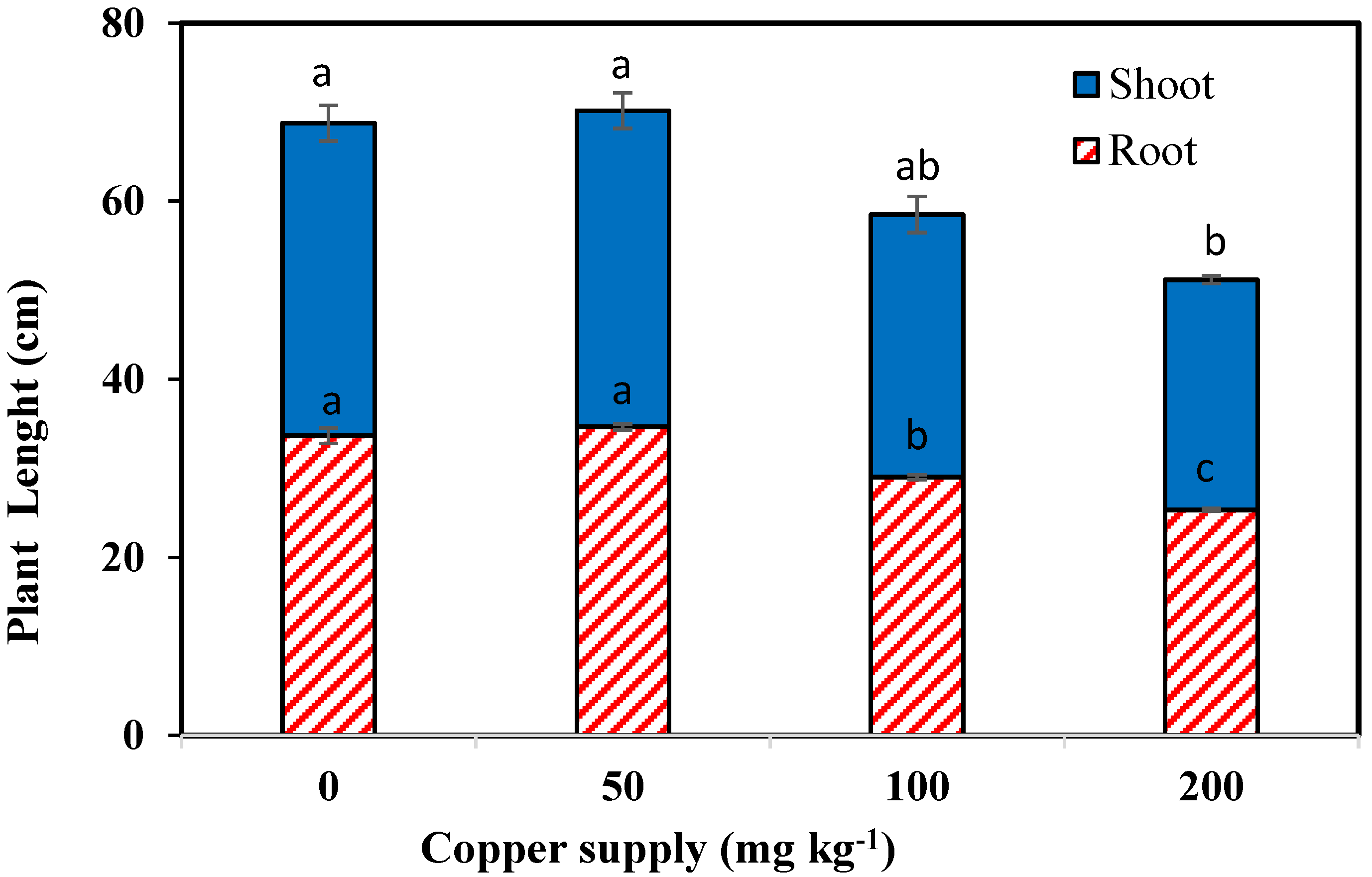
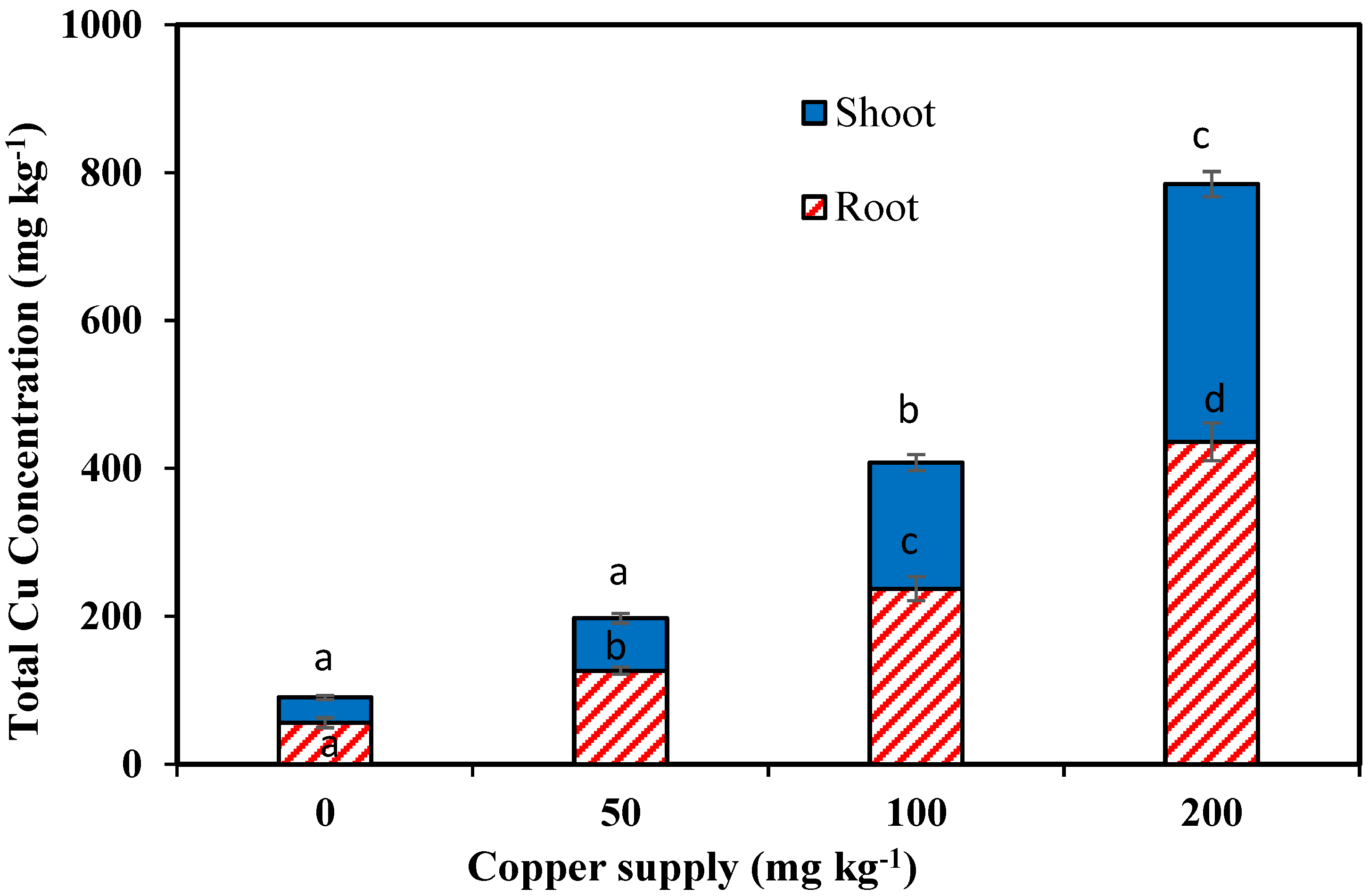
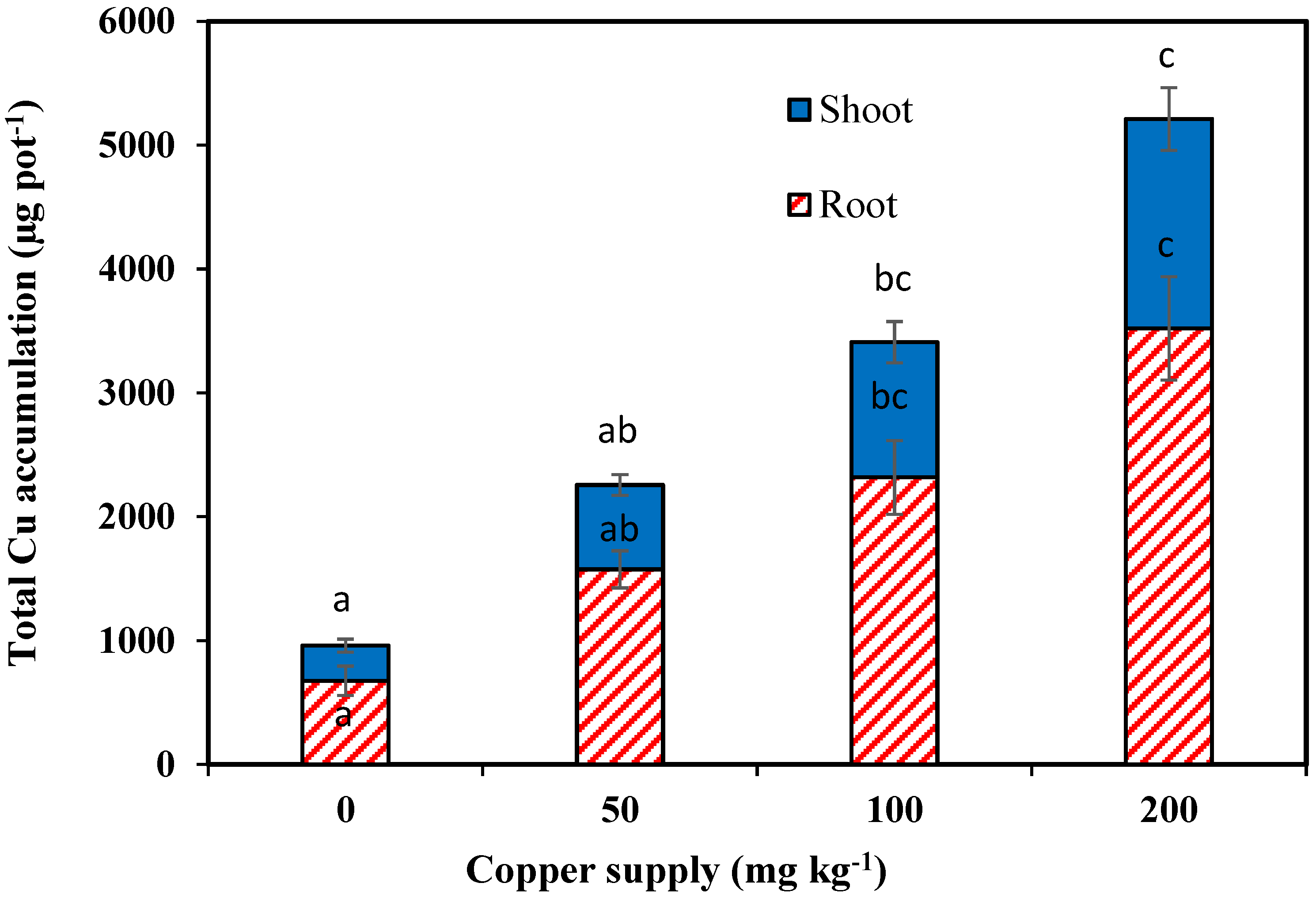
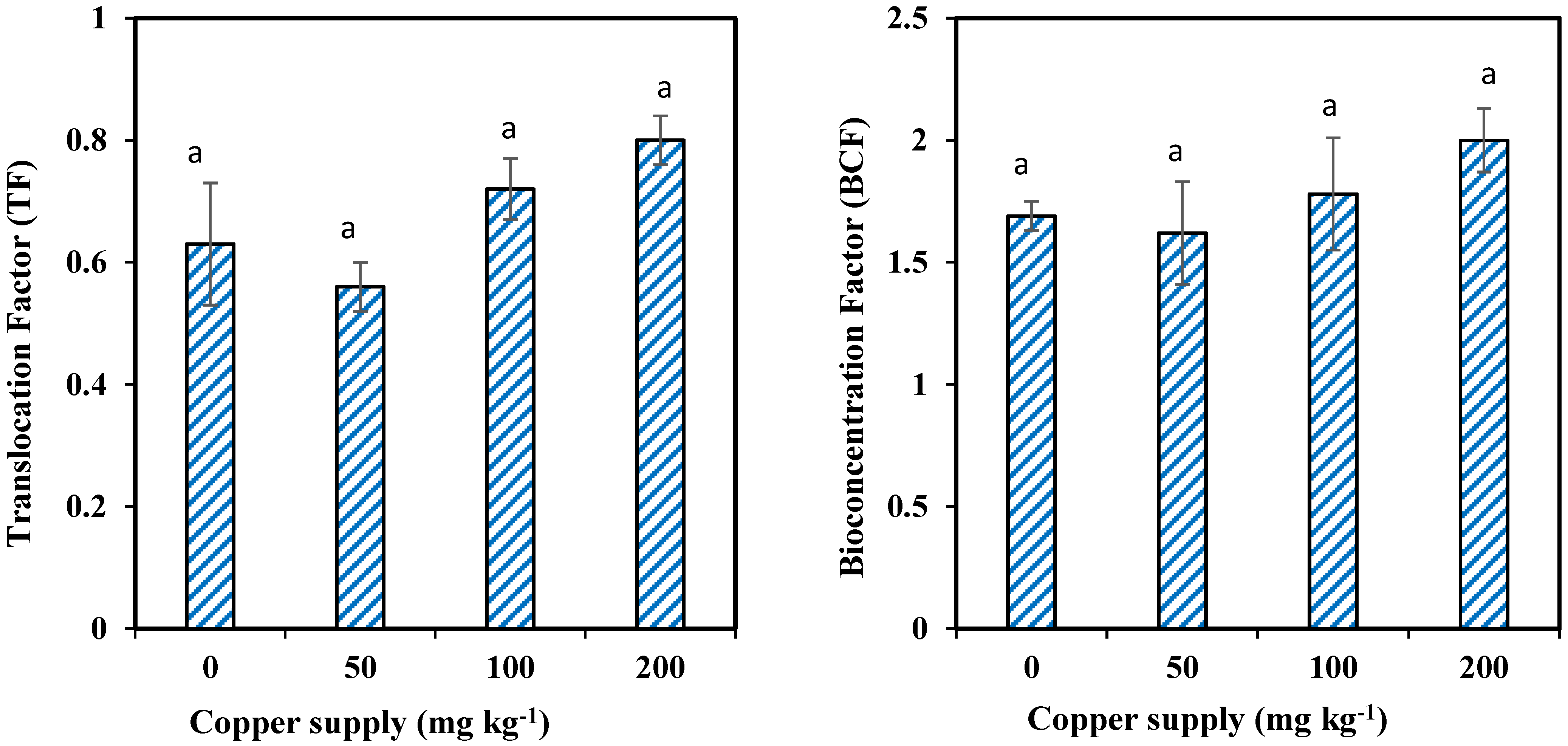
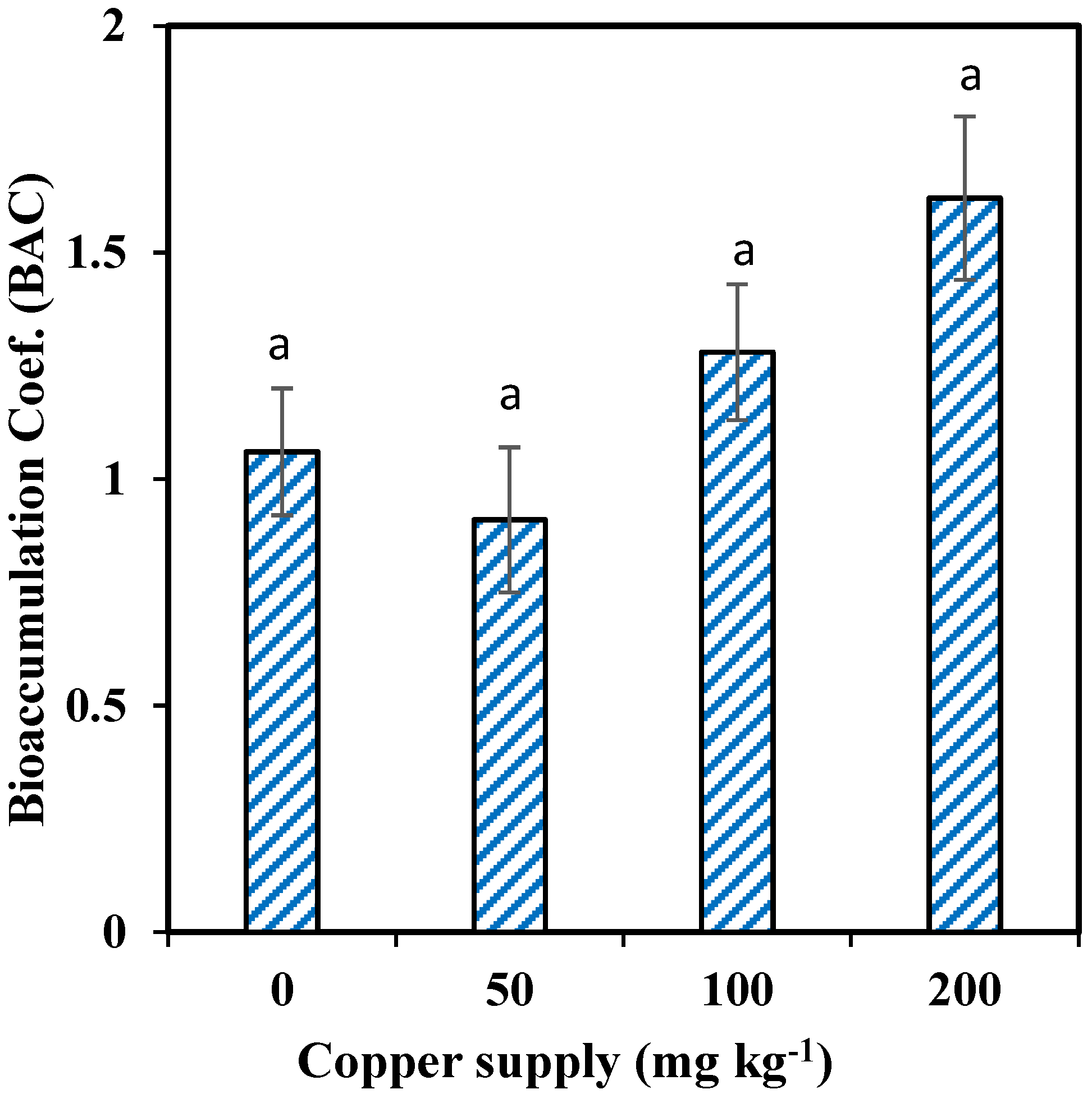
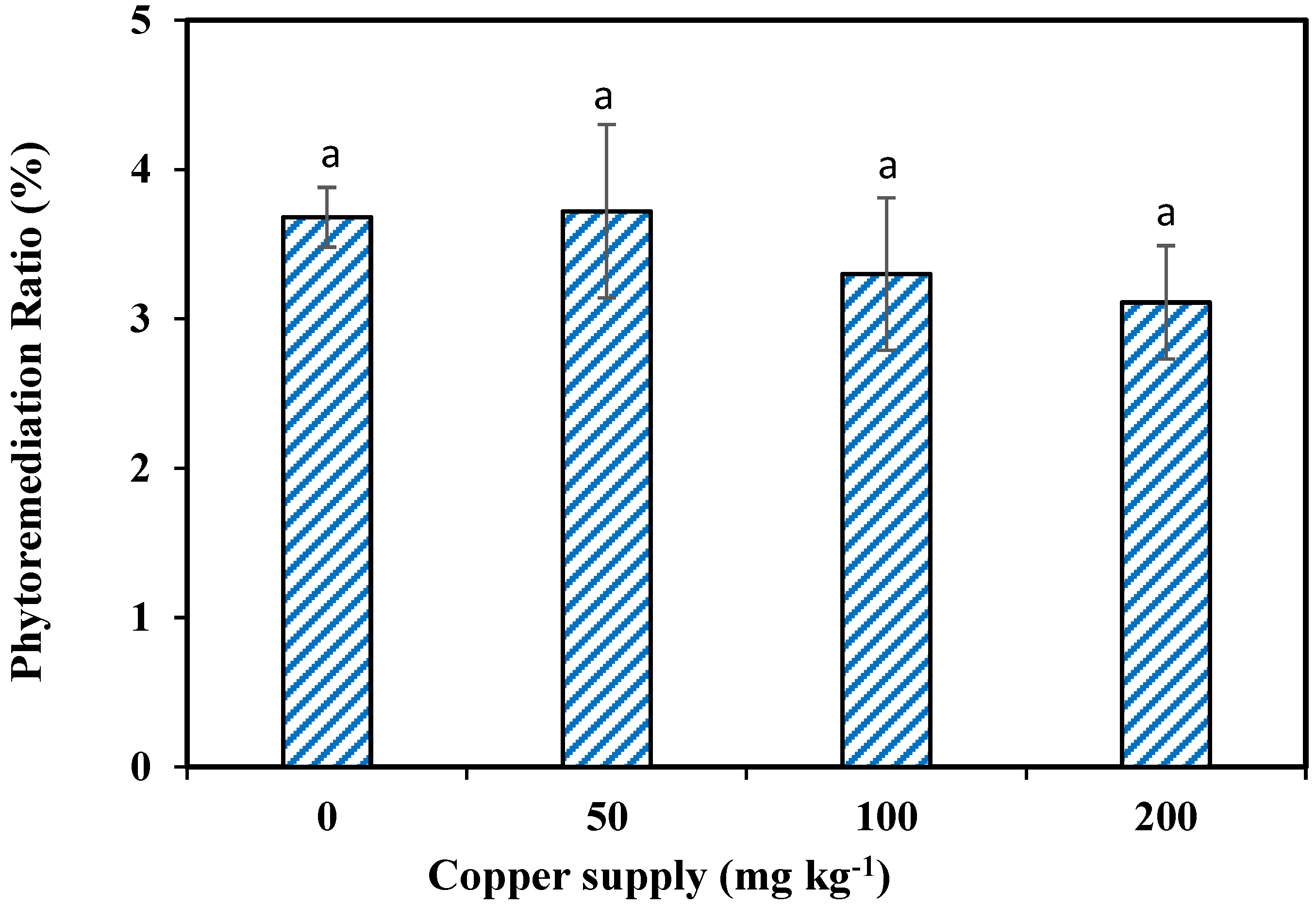
| Treatment | pH | EC (ds m−1) | OC (%) | Total N (%) | P (mg kg−1) | Total Cu (mg kg−1) |
|---|---|---|---|---|---|---|
| T1 (Control) † | 7.81 ± 0.15 * | 1.81 ± 0.04 | 0.78 ± 0.14 | 0.49 ± 0.06 | 8.18 ± 0.43 | 32.97 ± 3.41 |
| T2 (50 mg kg−1 Cu) | 7.58 ± 0.12 | 1.86 ± 0.08 | 0.69 ± 0.15 | 0.42 ± 0.07 | 7.52 ± 1.00 | 80.13 ± 8.38 |
| T3 (100 mg kg−1 Cu) | 7.19 ± 0.05 | 1.99 ± 0.11 | 0.62 ± 0.11 | 0.36 ± 0.05 | 6.80 ± 0.53 | 135.71 ± 11.30 |
| T4 (200 mg kg−1 Cu) | 6.87 ± 0.10 | 2.11 ± 0.10 | 0.57 ± 0.11 | 0.33 ± 0.06 | 5.62 ± 0.70 | 219.18 ± 19.75 |
Publisher’s Note: MDPI stays neutral with regard to jurisdictional claims in published maps and institutional affiliations. |
© 2022 by the authors. Licensee MDPI, Basel, Switzerland. This article is an open access article distributed under the terms and conditions of the Creative Commons Attribution (CC BY) license (https://creativecommons.org/licenses/by/4.0/).
Share and Cite
Daryabeigi Zand, A.; Mühling, K.H. Phytoremediation Capability and Copper Uptake of Maize (Zea mays L.) in Copper Contaminated Soils. Pollutants 2022, 2, 53-65. https://doi.org/10.3390/pollutants2010007
Daryabeigi Zand A, Mühling KH. Phytoremediation Capability and Copper Uptake of Maize (Zea mays L.) in Copper Contaminated Soils. Pollutants. 2022; 2(1):53-65. https://doi.org/10.3390/pollutants2010007
Chicago/Turabian StyleDaryabeigi Zand, Ali, and Karl H. Mühling. 2022. "Phytoremediation Capability and Copper Uptake of Maize (Zea mays L.) in Copper Contaminated Soils" Pollutants 2, no. 1: 53-65. https://doi.org/10.3390/pollutants2010007
APA StyleDaryabeigi Zand, A., & Mühling, K. H. (2022). Phytoremediation Capability and Copper Uptake of Maize (Zea mays L.) in Copper Contaminated Soils. Pollutants, 2(1), 53-65. https://doi.org/10.3390/pollutants2010007







